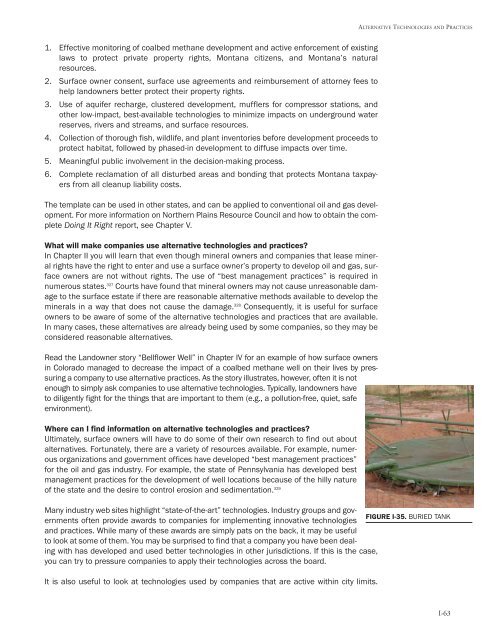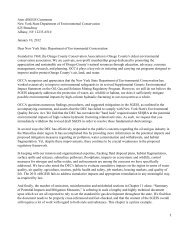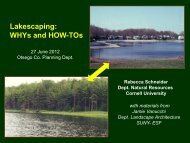Oil and Gas at Your Door? (2005 Edition) - Earthworks
Oil and Gas at Your Door? (2005 Edition) - Earthworks
Oil and Gas at Your Door? (2005 Edition) - Earthworks
Create successful ePaper yourself
Turn your PDF publications into a flip-book with our unique Google optimized e-Paper software.
ALTERNATIVE TECHNOLOGIES AND PRACTICES<br />
1. Effective monitoring of coalbed methane development <strong>and</strong> active enforcement of existing<br />
laws to protect priv<strong>at</strong>e property rights, Montana citizens, <strong>and</strong> Montana’s n<strong>at</strong>ural<br />
resources.<br />
2. Surface owner consent, surface use agreements <strong>and</strong> reimbursement of <strong>at</strong>torney fees to<br />
help l<strong>and</strong>owners better protect their property rights.<br />
3. Use of aquifer recharge, clustered development, mufflers for compressor st<strong>at</strong>ions, <strong>and</strong><br />
other low-impact, best-available technologies to minimize impacts on underground w<strong>at</strong>er<br />
reserves, rivers <strong>and</strong> streams, <strong>and</strong> surface resources.<br />
4. Collection of thorough fish, wildlife, <strong>and</strong> plant inventories before development proceeds to<br />
protect habit<strong>at</strong>, followed by phased-in development to diffuse impacts over time.<br />
5. Meaningful public involvement in the decision-making process.<br />
6. Complete reclam<strong>at</strong>ion of all disturbed areas <strong>and</strong> bonding th<strong>at</strong> protects Montana taxpayers<br />
from all cleanup liability costs.<br />
The templ<strong>at</strong>e can be used in other st<strong>at</strong>es, <strong>and</strong> can be applied to conventional oil <strong>and</strong> gas development.<br />
For more inform<strong>at</strong>ion on Northern Plains Resource Council <strong>and</strong> how to obtain the complete<br />
Doing It Right report, see Chapter V.<br />
Wh<strong>at</strong> will make companies use altern<strong>at</strong>ive technologies <strong>and</strong> practices?<br />
In Chapter II you will learn th<strong>at</strong> even though mineral owners <strong>and</strong> companies th<strong>at</strong> lease mineral<br />
rights have the right to enter <strong>and</strong> use a surface owner’s property to develop oil <strong>and</strong> gas, surface<br />
owners are not without rights. The use of “best management practices” is required in<br />
numerous st<strong>at</strong>es. 327 Courts have found th<strong>at</strong> mineral owners may not cause unreasonable damage<br />
to the surface est<strong>at</strong>e if there are reasonable altern<strong>at</strong>ive methods available to develop the<br />
minerals in a way th<strong>at</strong> does not cause the damage. 328 Consequently, it is useful for surface<br />
owners to be aware of some of the altern<strong>at</strong>ive technologies <strong>and</strong> practices th<strong>at</strong> are available.<br />
In many cases, these altern<strong>at</strong>ives are already being used by some companies, so they may be<br />
considered reasonable altern<strong>at</strong>ives.<br />
Read the L<strong>and</strong>owner story “Bellflower Well” in Chapter IV for an example of how surface owners<br />
in Colorado managed to decrease the impact of a coalbed methane well on their lives by pressuring<br />
a company to use altern<strong>at</strong>ive practices. As the story illustr<strong>at</strong>es, however, often it is not<br />
enough to simply ask companies to use altern<strong>at</strong>ive technologies. Typically, l<strong>and</strong>owners have<br />
to diligently fight for the things th<strong>at</strong> are important to them (e.g., a pollution-free, quiet, safe<br />
environment).<br />
Where can I find inform<strong>at</strong>ion on altern<strong>at</strong>ive technologies <strong>and</strong> practices?<br />
Ultim<strong>at</strong>ely, surface owners will have to do some of their own research to find out about<br />
altern<strong>at</strong>ives. Fortun<strong>at</strong>ely, there are a variety of resources available. For example, numerous<br />
organiz<strong>at</strong>ions <strong>and</strong> government offices have developed “best management practices”<br />
for the oil <strong>and</strong> gas industry. For example, the st<strong>at</strong>e of Pennsylvania has developed best<br />
management practices for the development of well loc<strong>at</strong>ions because of the hilly n<strong>at</strong>ure<br />
of the st<strong>at</strong>e <strong>and</strong> the desire to control erosion <strong>and</strong> sediment<strong>at</strong>ion. 329<br />
Many industry web sites highlight “st<strong>at</strong>e-of-the-art” technologies. Industry groups <strong>and</strong> governments<br />
often provide awards to companies for implementing innov<strong>at</strong>ive technologies<br />
FIGURE I-35. BURIED TANK<br />
<strong>and</strong> practices. While many of these awards are simply p<strong>at</strong>s on the back, it may be useful<br />
to look <strong>at</strong> some of them. You may be surprised to find th<strong>at</strong> a company you have been dealing<br />
with has developed <strong>and</strong> used better technologies in other jurisdictions. If this is the case,<br />
you can try to pressure companies to apply their technologies across the board.<br />
It is also useful to look <strong>at</strong> technologies used by companies th<strong>at</strong> are active within city limits.<br />
I-63




